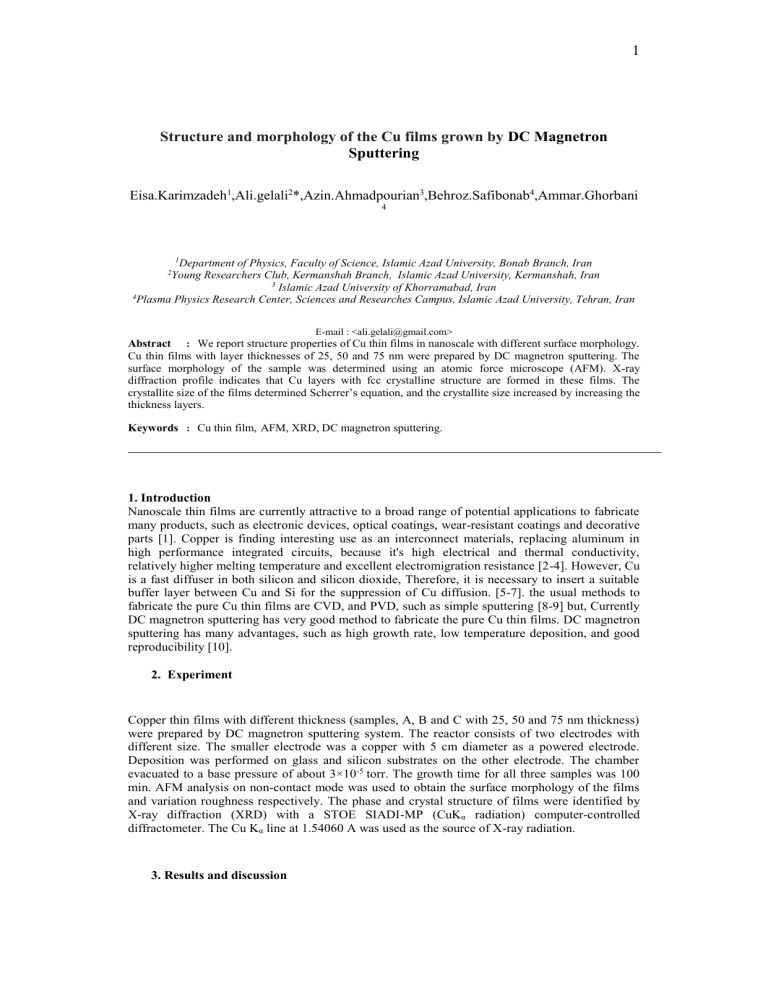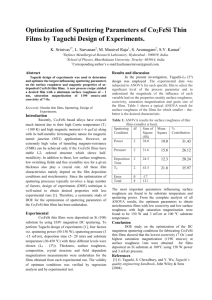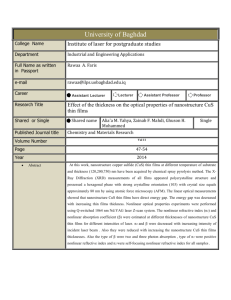1 Structure and morphology of the Cu films grown by DC Magnetron

1
Structure and morphology of the Cu films grown by DC Magnetron
Sputtering
Eisa.Karimzadeh
1
,Ali.gelali
2
*,Azin.Ahmadpourian
3
,Behroz.Safibonab
4
,Ammar.Ghorbani
4
1 Department of Physics, Faculty of Science, Islamic Azad University, Bonab Branch, Iran
2 Young Researchers Club, Kermanshah Branch, Islamic Azad University, Kermanshah, Iran
3 Islamic Azad University of Khorramabad, Iran
4 Plasma Physics Research Center, Sciences and Researches Campus, Islamic Azad University, Tehran, Iran
E-mail : <ali.gelali@gmail.com>
Abstract : We report structure properties of Cu thin films in nanoscale with different surface morphology.
Cu thin films with layer thicknesses of 25, 50 and 75 nm were prepared by DC magnetron sputtering. The surface morphology of the sample was determined using an atomic force microscope (AFM). X-ray diffraction profile indicates that Cu layers with fcc crystalline structure are formed in these films. The crystallite size of the films determined Scherrer’s equation, and the crystallite size increased by increasing the thickness layers.
Keywords : Cu thin film, AFM, XRD, DC magnetron sputtering.
1. Introduction
Nanoscale thin films are currently attractive to a broad range of potential applications to fabricate many products, such as electronic devices, optical coatings, wear-resistant coatings and decorative parts [1]. Copper is finding interesting use as an interconnect materials, replacing aluminum in high performance integrated circuits, because it's high electrical and thermal conductivity, relatively higher melting temperature and excellent electromigration resistance [2-4]. However, Cu is a fast diffuser in both silicon and silicon dioxide, Therefore, it is necessary to insert a suitable buffer layer between Cu and Si for the suppression of Cu diffusion. [5-7]. the usual methods to fabricate the pure Cu thin films are CVD, and PVD, such as simple sputtering [8-9] but, Currently
DC magnetron sputtering has very good method to fabricate the pure Cu thin films. DC magnetron sputtering has many advantages, such as high growth rate, low temperature deposition, and good reproducibility [10].
2. Experiment
Copper thin films with different thickness (samples, A, B and C with 25, 50 and 75 nm thickness) were prepared by DC magnetron sputtering system. The reactor consists of two electrodes with different size. The smaller electrode was a copper with 5 cm diameter as a powered electrode.
Deposition was performed on glass and silicon substrates on the other electrode. The chamber evacuated to a base pressure of about 3×10 -5 torr. The growth time for all three samples was 100 min. AFM analysis on non-contact mode was used to obtain the surface morphology of the films and variation roughness respectively. The phase and crystal structure of films were identified by
X-ray diffraction (XRD) with a STOE SIADI-MP (CuK
α
radiation) computer-controlled diffractometer. The Cu K
α
line at 1.54060 A was used as the source of X-ray radiation.
3. Results and discussion
2
The 3D surface morphology of the films is shown in fig. 1; the root mean square (RMS) of surface roughness over an area of 5μm × 5μm was obtained from AFM data too. The RMS roughness is
1.10 nm for the as-deposited copper film with thickness 25 nm that indicates uniform coverage and tendency to agglomeration. As the deposition thickness increased to 50 (Fig. 1B) small islands, presumably of copper, were formed on the surface with sharp peak , lead to increasing the rms roughness to 1.84 nm, with increased thickness to 75 nm, The surface became much rougher, having an RMS roughness of 11.7 nm(fig.1C). Thus it can be seen that the surface roughness is a function of thickness (fig.2), because mountains, valleys and island clusters become bigger [11].
Maybe, this behavior is caused by the aggregation of the native grains into the larger clusters.
X-ray diffraction patterns are shown in fig.3a for Cu films grown on Si (100) substrates. As it is evident in this figure, fcc Cu nanocrystals with (111), (200) orientations are grown in this film [12-
13]. The peak in the range of 40-47 is smoothed and redrawn in fig.3b .this peak was deconvoluted two peaks labeled as peak Cu (111) and Cu peak of Cu
2
2
O .The peak of Cu (111) appears at 43.49° and the
O does at 42.19°. The peaks at 69° and 87° are related to Si substrate.
So the conclusive result from XRD studies was a presence of Polycrystalline growth of Cu film grown on substrate.
XRD was used to identify the crystal structure and to estimate the average crystallite size by scherrer’s equation, too
D
0 .
9
BCos
Where λ is the wave length of cu K
α
, β is the FWHM of the diffraction peak; θ is the position [14].
The crystallite size obtained from the FWHM by scherrer’s equation (table 1). It can be observed from Table 1 that, for films with similar phase composition, the average size, D, of the crystallites increases with increasing film thickness during film deposition. This behavior can be explained from general mechanisms of nucleation, growth and structure of thin films [15].
5. Conclusion
Nanoscale Cu thin films with different thickness were prepared by DC magnet sputtering. The effect of thickness on surface morphologies and structure are investigated by AFM and XRD analyses. The study shows polycrystalline growth of the Cu films.
In initial stages of films creation because of random and high rate of deposition, thin film has poor time for crystallization. But with increase of thickness of film, because of following of particles from down layer, the films are more crystallized gradually. This event is clear in XRD results. This event is reason of rise of height of mountain in the AFM 3D images that leads to increase of RMS roughness.
References
[1]
S Sim˜oes, R Calinas, M T Vieira, M F Vieira and P J Ferreira. IOP PUBLISHING,
Nanotechnology21 , 14570, (stacks.iop.org/Nano/21/145701),1(2010)
[2] Wei-Yang Chou, Bing-Yue Tsui, Chia-Wei Kuo and Tsung-Kuei Kang. Journal of the Electrochemical
Society, 152 (2005)
[3] T. Ghodselahi, M.A. Vesaghi, A. Shafiekhani, A. Baradaran, A. Karimi, Z. Mobini. Surface &
Coatings Technology 202, 2731–2736, (2008)
[4] S.P. Muraka, I.V. Verner, and R.J. Gutmann, Copper Fundamental Mechanisms for Microelectronic
Applications(Wiley, 2000)
[5] Y. J. Kim, K. K. Choi, and O. Kim, IEEE Electron Device Lett., 23, (2002)
[6] R. N. Hall and J. H. Racette, J. Appl. Phys., 35,(1964)
3
[7] Yee-Wen Yen, Yu-Lin Kuo, Jian-Yu Chen, Chiapyng Lee, Chung-Yu Lee. Thin Solid Films 515 , 7209–
7216(2007)
[8] N. Awaya, Y. Arita, Jpn. J. Appl. Phys. 30 (1991) 1813
[9] W. Eang, J. Foster, A.E. Wendt, J.H. Booske, T. Onuoha, P.W. Sandstrom, H. Liu, S.S. Gearhart, N.
Hershkowita, Appl. Phys. Lett.71 (1997) 1622
[10] Jin-Hyo Boo, Min Jae Jung, Heon Kyu Park, Kyung Hoon Nam, Jeon G. Han, Surface & Coatings
Technology 188–189 (2004) 721– 727
[11] Ali Gelali , Azin Ahmadpourian , Reza Bavadi ,M. R. Hantehzadeh, Arman Ahmadpourian. J. Fusion
Energ.(springer) (2012)
[12] H.C. Barshilia, K.S. Rajam, Surf. Coat. Technol. 155 (2002)
[13] Bo Hong, Chuan-Hai Jiang, Xin-Jian Wang, Surf. Coat. Technol. 201 (2007)
[14] M. R. Hantehzadeh , R. Bavadi , A. H. Sari, M. Ghoranneviss. J. Fusion Energ. (springer) (2011)
[15] Diana Mardare, C. Baban, Raluca Gavrila, M. Modreanu, G.I. Rusu. Surface Science 507–510,
(2002.
Fig. 1. An AFM image of thin films with different thickness (A) 25 nm (B), 50 nm (C) 75 nm.
Fig.2: RMS roughness versus thickness of layers.
4
C
Samples
A
B
Fig. 3. XRD patterns of Cu thin films with different thickness.
Table. 1. Crystallite size of Cu (111) thin films.
2 Theta (deg)
43
43.51
FWHM (rad)
--
0.0107
43.49 0.0096
C.size (nm)
-
17
20
5





